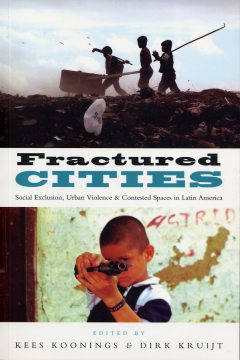
BOOK
Fractured Cities
Doctor Elisabeth Leeds | Wil Pansters | Ralph Rozema | Doctor Dennis Rodgers | Professor Caroline Moser | Doctor Cathy McIlwaine | Carlos Ivan Degregori | Roberto Briceno-Leon | Kees Koonings | Dirk Kruijt
(2008)
Additional Information
Book Details
Abstract
As cities sprawl across Latin America, absorbing more and more of its people, crime and violence have become inescapable.
From the paramilitary invasion of Medell¡n in Colombia, the booming wealth of crack dealers in Managua, Nicaragua and police corruption in Mexico City, to the glimmers of hope in Lima, this book provides a dynamic analysis of urban insecurity. Based on new empirical evidence, interviews with local people and historical contextualization, the authors attempts to shed light on the fault-lines which have appeared in Latin American society.
Neoliberal economic policy, it is argued, has intensified the gulf between elites, insulated in gated estates monitored by private security firms, and the poor, who are increasingly mistrustful of state-sponsored attempts to impose order on their slums. Rather than the current trend towards government withdrawal, the situation can only be improved by co-operation between communities and police to build new networks of trust. In the end, violence and insecurity are inseparable from social justice and democracy.
Kees Koonings is Associate Professor of Development Studies in the Faculty of Social Sciences, Utrecht University.
Dirk Kruijt is Professor of Development Studies in the Faculty of Social Sciences, Utrecht University.
Table of Contents
| Section Title | Page | Action | Price |
|---|---|---|---|
| Cover | Cover | ||
| Contents | v | ||
| Tables and figures | vii | ||
| Acknowledgements | viii | ||
| Introduction: the duality of Latin American cityscapes | 1 | ||
| 1 | Fractured cities, second-class citizenship and urban violence | 7 | ||
| Urban poverty, desborde popular and the erosion of the formal social order | 8 | ||
| Conceptualizing exclusion, insecurity and violence | 11 | ||
| Armed actors and violence brokers | 14 | ||
| The politics of urban violence | 17 | ||
| Parallel power and perverse integration | 19 | ||
| Notes | 21 | ||
| 2 | Rio de Janeiro | 23 | ||
| Favela-related violence | 24 | ||
| Impact on education | 25 | ||
| Motives for involvement in drugs trading | 26 | ||
| Police and community – negative dialogues | 27 | ||
| Political-administrative constraints | 30 | ||
| Police oversight and the lack of political will | 32 | ||
| Conclusions | 34 | ||
| Notes | 35 | ||
| 3 | Mexico City | 36 | ||
| Violence as fact and phantom | 36 | ||
| Metropolitan structure and security governance | 38 | ||
| Patterns and actors of insecurity and violence | 40 | ||
| Governmental and societal responses and strategies | 47 | ||
| Conclusions | 53 | ||
| Notes | 55 | ||
| 4 | Medellín | 57 | ||
| A history of urban violence in Medellín | 58 | ||
| Daily life under guerrillas and paramilitaries | 60 | ||
| A promising peace process with the paramilitaries | 65 | ||
| Concluding remarks | 69 | ||
| Note | 70 | ||
| 5 | Managua | 71 | ||
| Barrio Luis Fanor Hernández: past and present | 73 | ||
| Drugs, material wealth and conspicuous consumption | 75 | ||
| Consumption, cultural exclusion and predation | 79 | ||
| Violence and primitive accumulation | 80 | ||
| Conclusion | 84 | ||
| Notes | 85 | ||
| 6 | Caracas | 86 | ||
| Divided Caracas | 86 | ||
| The advent of violence in Caracas | 88 | ||
| Forms of violence | 93 | ||
| Fear as an urban sentiment | 96 | ||
| The loss of the city | 97 | ||
| Democracy and violence in the city | 99 | ||
| 7 | Lima Metropolitana | 101 | ||
| City of informales | 102 | ||
| New social actors and new forms of popular organization | 105 | ||
| Low-intensity violence | 110 | ||
| Conclusion | 113 | ||
| Notes | 114 | ||
| 8 | Living in fear: how the urban poor perceive violence, fear and insecurity | 117 | ||
| The diversity and complexity of violence among the urban poor | 118 | ||
| Social fragmentation and spatial restrictions | 120 | ||
| The legitimization of violence among the urban poor I | 125 | ||
| The legitimization of violence among the urban poor II | 131 | ||
| Non-violent coping: a gendered response | 134 | ||
| Conclusions | 135 | ||
| Notes | 136 | ||
| Epilogue: Latin America’s urban duality revisited | 138 | ||
| About the authors | 142 | ||
| Bibliography | 144 | ||
| Index | 161 |
